In the U.S., May 1 has become known as College Signing Day, the day many colleges and universities ask students to declare their intent to enroll at the institution.
“College Signing Day is important because it was the day we launched Reach Higher at the White House in 2014,” said Eric Waldo, President and CEO of the D.C. College Access Program (DCCAP) and founding executive director for First Lady Michelle Obama’s Reach Higher initiative. “That year, there were maybe only 12 citywide College Signing Day events taking place. By 2019, there were over 3,000 events happening in all 50 states and 7 foreign countries, and over 1 billion hashtag impressions [about college decisions] in a 24 hour period.”
By this time of year, typically, students have received financial aid packages from the institutions where they have been accepted, and students and families have compared the various financial aid information to help inform a college decision. Given the bungled rollout of the Better FAFSA, College Signing Day looked a lot different this year.
As a result of many of the glitches with this year’s FAFSA form, many colleges and universities extended their deadlines beyond May 1. However, many institutions – most notably, some of the nation’s most exclusive universities – did not make a change to their ‘decision day’ deadline. For those students, some experts fear that students may either blindly declare their intention to enroll, or forgo higher education altogether, given they don’t have aid packages to compare.
All hope is not lost. Some states and institutions have already been exploring the potential of emerging technology to support FAFSA completion. Washington state’s OtterBot, developed by Mainstay, provides free support to students to help them navigate the application and financial aid processes. One recent study at Georgia State University found statistically significant increases in FAFSA filing from students who communicated with the chatbot throughout the process.
The U.S. Department of Education (ED) announced new actions to help individuals from mixed status families complete the FAFSA. In the same announcement, ED indicated that schools are now receiving students’ financial aid information within 1-3 days of the student submitting information which gets colleges the information they need to be able to formulate financial aid packages much faster than earlier in the process.
“Despite all the challenges with the FAFSA – and they are real – the high school class of 2024 has preserved through so much. They started high school during a global pandemic. College Signing Day still has a role to play to celebrate students – and remind them that college is worth it,” said Waldo.




